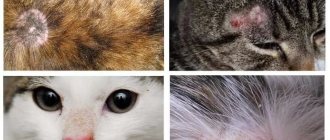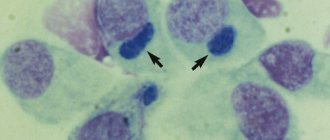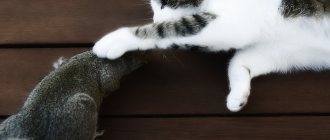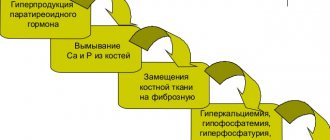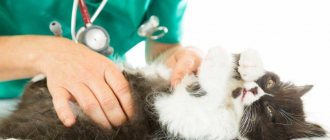Providing first aid and treating bruises in cats is of great importance for the future health of the pet. Veterinarians diagnose several types of injuries. Most often the head, jaws, fore and hind limbs, chest, abdomen, internal organs, spine and tail are injured. Any injury can become fatal if the owner does not show the pet to the doctor in a timely manner.
According to veterinarian statistics, 15% of cats are injured due to the owner’s carelessness when falling from a height.
First aid: what to do?
Any injury threatens the life of the animal, so the owner must urgently take the pet to the veterinary clinic. Depending on which part of the body is injured, the owner’s pre-medical actions should be as follows:
Before visiting the doctor, the pet owner can use a cold compress.
- Provide your pet with complete rest.
- Apply a cold compress to the injured part of the body.
- Treat the wound with hydrogen peroxide, being careful not to touch bone fragments in open injuries.
- Place the cat on a hard, flat surface, securing it with a wide belt in case of a spinal injury.
- Secure the limb with planks, placing a cotton-gauze pad between the paw and the fixator.
- Wear a protective collar or secure the jaw with a bandage.
- In case of chest injuries, leave the animal in the position in which it is comfortable, placing it on a hard surface.
General information about first aid
First aid is the urgent implementation of one or more medical actions necessary in emergency situations.
They are undertaken for injured and sick cats immediately on the spot in case of accidents, before the veterinarian arrives. Therapeutic actions are aimed at improving well-being, removing pain, relieving symptoms of the disease, preventing additional injuries, and reducing the risk of death.
To organize first aid for a cat after being injured, you will need a first aid kit. Therefore, it should be in every apartment where an animal lives.
There are no standards for the contents of a first aid kit. Its equipment depends on the breed of the cat. However, there are a number of medical instruments, things, drugs that should be in it.
Of the tools and things, the main components of a first aid kit are:
- sterile bandage;
- elastic band;
- adhesive plaster;
- scissors,
- tweezers;
- thermometer;
The first aid kit should also contain such things as a syringe, pipette, and cotton swabs.
To provide first aid, your cat will need medications from the following pharmacological groups:
- antiseptics;
- analgesics;
- antibiotics;
- antiemetics;
- antihistamines;
- sedatives;
- cardiovascular.
Each medicine has side effects and rules of use. Before using them, you should carefully read the instructions.
How to treat injuries?
The treatment regimen for the cat is determined by the veterinarian; self-medication is prohibited. Most severe injuries are treated with surgery using osteosynthesis instruments, blood transfusion, and thoracentesis are performed. The broken limb is fixed with a splint. Depending on the type of injury, antibiotics, sedatives, painkillers, and antiemetics are prescribed. If the musculoskeletal system is damaged, after treatment, physiotherapy and rehabilitation exercises are prescribed. If the cat does not walk, a wheelchair is required.
Requirements for organizing first aid
First aid for an injured cat is organized until a veterinarian or animal rescue service arrives. During this time, the life of the animal depends on compliance with the rules of medical procedures, as well as the implementation of therapeutic actions by the owner.
How to get rid of cat urine smell forever
Why are cats afraid of water?
Vaccinations for Scottish kittens
There are two basic requirements for cat emergency care.
Inspection of the accident site
Before you begin first aid, you must carefully inspect the scene of the incident. A visual survey will make it possible to identify additional threats to the life of the animal, the owner himself, and surrounding people.
Increased hazard risks include:
- fire;
- exposed electrical wires;
- heavy traffic flow;
- smoke;
- depth and pollution of the reservoir:
- bad weather conditions;
- evaporation of toxins.
If danger is detected, you should not approach the injured cat. In this case, you need to call the animal rescue service. The rescue squad is equipped with emergency equipment and trained in all first aid skills.
Initial examination
Cats may lose consciousness briefly after being injured. Fainting is not a diagnosis. It is a serious symptom of a pathological disorder of cerebral circulation. To identify the causes of the condition and eliminate it, it is necessary to conduct an initial examination of the cat. Otherwise, minor injuries will lead to his death.
The initial examination of an unconscious animal includes:
- Breathing test. Its presence is indicated by the rising and falling of the chest. Breathing can be noticed visually or felt by placing your hand on the animal’s chest.
- Pulse check. This procedure is carried out in the absence of breathing. The heartbeat is determined by gentle pressure of the hand on the inner thigh.
If it is not possible to detect breathing or a pulse, the cat requires emergency assistance.
Performing an emergency
The complex of emergency medical actions includes artificial ventilation of the lungs with cardiac massage.
Artificial respiration is performed on a cat in the following order:
- The animal is laid on its right side.
- Use your fingers to open the cat's mouth.
- The mouth is cleaned with a handkerchief.
- The owner's mouth is placed on the cat's nose.
- Air is exhaled into the sinuses.
Exhalation is done every 5 seconds. In 1 minute, breathing movements are performed 12 to 15 times. Therapeutic actions are repeated until the cat shows signs of breathing.
In parallel with artificial ventilation, the animal needs to undergo cardiac massage.
The procedure for restoring the heartbeat is carried out as follows:
- The owner's thumb rests on the cat's chest.
- The remaining fingers are located on the opposite side of the body.
- Toward the neck, the animal’s chest is sharply compressed with the hand 6 times.
- After contracting the pectoral muscles, the cat exhales once.
These actions alternate with each other until the cat’s heart begins to beat. Then only artificial respiration is performed.
First aid for injuries in cats. Painkillers for cats
The damage can be identified by examining the wound; sometimes it contains bone fragments. The pet does not step on the damaged paw and tries to fix it in a gentle position. When these signs appear, owners should worry about the health of their pet.
Splinting
If your cat has an unfortunate fall or was hit by a car and you suspect that one of its legs is broken, you should try to apply a splint. The splint can be a flat board or thick cardboard folded several times, which you should wrap with several layers of bandage.
A splint is needed to immobilize the broken limb. To do this, the splint is placed so as to capture the two joints closest to the fracture. So you can roughly see where the cat broke its paw and immobilize the joint on top of the break and the joint on the bottom of the break.
If the cat gives it to you, without straightening or forcibly bending its paw, carefully place one splint (for the front paw) or two (for the back paw) - along the inner outer surface of the thigh, depending on which limb is broken, then bandage the splint to the paw. As you understand, the main task when applying a splint is to make sure that the cat moves the injured limb as little as possible.
If the cat behaves restlessly, twitches, does not let you near you, jumps and gallops, this can lead to further damage to the broken limb. In this case, it is better to take her by the scruff of the neck (the elder’s grip) and put her in a narrow box, cage, basket - in a place where she will not be able to move. And in this form, take it to the veterinarian.
When a back leg is broken, it is immediately obvious: when you lift the cat by the armpits, it seems to fall off. With pelvic fractures, the cat cannot stand. With rib fractures, the cat cannot breathe normally; breathing is frequent and shallow. The cat may experience acute pain, fear, and anxiety. If you have the opportunity (try to have one), give her a painkiller injection.
We suggest you read: Causes of heavy breathing in cats and what to do
In case of open fractures, when tissue is damaged, there is an open wound, a broken bone is visible - you cannot do anything yourself. No antiseptics or ointments!
Open fracture
First, you need to take your pet to a convenient place for carrying, for example, a box, and immediately take it to the doctor. If the cat actually breaks its paw and is diagnosed with a fracture, the veterinarian will apply a splint. Of course, such a splint can be applied at home, but this should be done very carefully, but it is better not to try and take it to a veterinary clinic.
After first aid to the victim, he must be taken for an x-ray to recognize the area of damage and the characteristics of the injury.
Again, there is a high body temperature, there is heavy bleeding from the wound, because muscle tissue is ruptured. In this case, doctors will have to set the crushed bones, the pet itself will be under anesthesia. After this procedure, a plaster cast is applied.
In case of particularly serious injuries, surgery is prescribed for the pet. This operation differs from others in that the animal is given a pin with fastening after shaving the hair from the damaged area in advance; this occurs under anesthesia.
• Give an anesthetic injection.
• Cover the wound with sterile gauze pads.
• Bandage.
• Apply and bandage a splint on top. • Contact a veterinarian immediately.
As you can see, you will have to learn how to give your cat injections. Don't be alarmed, there is nothing complicated about it. Next I will explain the technology of this simple matter.
Why does a cat need painkillers for fractures and dislocations? Because any injury can lead to traumatic shock.
This is the body's reaction to severe pain, and the state of traumatic shock poses a serious danger.
DISLOCATION
A joint is where the two ends of a bone meet. With injuries, sometimes a condition occurs in which their mutual contact is completely or partially disrupted.
Sometimes the head (end) of one bone comes completely out of the joint. In this case, the limb is modified, shortened or lengthened, and the joint is sharply deformed. The cat is in severe pain and meows loudly. The joint swells and becomes hot to the touch.
Do not adjust the dislocation yourself! Without knowing cat anatomy, you can only do harm!
It is better to apply an ice pack, give an anesthetic injection, and very carefully apply a tight fixing bandage. Then immediately run to the doctor! Remember, the cat suffers a lot, dislocations are painful. What painkillers can be used for cats. • Butomidor is a strong painkiller for cats and dogs, administered subcutaneously - 0.04 ml per 1 kg of weight (i.e.
Home care
At first, the owner’s task is quite simple - to prevent any movements of the pet that could lead to displacement of the fixing devices and damage to the spinal cord. In addition, it is the owner who will have to care for the cat, helping him eat and removing waste products of the animal. It is especially important to monitor for limited mobility in cases where the front was treated using surgical techniques.
If a bandage is applied to the animal’s body, limiting the cat’s mobility, it is necessary to monitor its condition. He is inspected daily for chafing, redness, swelling, and inflamed areas of the skin that the fixation device comes into contact with. If wounds and redness are detected, you must immediately contact your veterinarian, otherwise the consequences will be dire (sepsis and death). In cases where the edges of the fracture were fixed surgically, the postoperative field must also be carefully examined daily. There should be no signs of swelling, inflammation or exudate. Surgical staples and sutures are removed approximately 10-14 days after surgery.
At least once every two weeks, it is necessary to take x-rays of the affected area of the spine in order to monitor in “real time” the process of healing and healing of fracture sites. Do not expect that after successful healing of the injuries, your pet will be able to immediately return to normal life. It will take him at least three to four months for his body to fully recover. To help the cat in this difficult matter, it is recommended to massage his long-suffering back , since in this case the process of restoring muscle tone and building bone mass goes much faster. So restoring your pet to normal is in your hands!
Since many cases of spinal fractures are a consequence of cats getting hit by cars and other vehicles, it is recommended to let the animal go outside less often if they live near major highways. For the same purpose, you can spay and neuter your pets, as this significantly discourages them from wandering. The less often your pet wanders the street, the less chance he has of getting fractures and other serious injuries.
Bruised paw in a cat - symptoms, treatment, definition
Cats are highly mobile, especially when young; when, while playing, they can perform complex tricks, which often end in injury in an apartment.
Sometimes even the dog, with whom the cat is friends, can accidentally inflict minor damage during play. A fall from a height usually causes concussions, fractures and bruises of varying severity. If the cat has free access to the street, the risk of injury increases.
In such a situation, the owner can easily face the fact that the cat’s paw is bruised. This phenomenon does not pose a danger, but requires proper treatment so that the inflammatory process does not begin.
It is also important for owners of four-legged pets to be able to distinguish a simple bruise from more serious injuries, such as fractures and dislocations that require the intervention of a veterinarian.
How to distinguish between a fracture and a dislocation
When a cat has injured its paw, you need to be able to distinguish a bruise from a fracture and dislocation, so that in case of serious damage you can immediately seek veterinary help. The main manifestations of a fracture are :
- violation of the paw configuration;
- acute pain, due to which the cat constantly meows loudly and does not even try to step on its paw;
- upon palpation, bone instability is determined;
- swelling not only at the site of the impact, but throughout the entire paw
In such a situation, you need to urgently visit a veterinarian. If the cat has suffered a dislocation, then the place where the bone exits the joint is clearly visible. The paw hangs and the animal cannot use it. In case of dislocation, specialist help is necessary.
Only if the cat is bruised will it be possible to carry out therapy on your own.
However, if a kitten’s paw is bruised, it is better to immediately contact a veterinarian, since in an active baby it is not always possible to correctly assess the severity of the injury on your own.
© shutterstock
Providing first aid to cats for various wounds
The highest threshold for injury in animals occurs in the summer. During the summer season, cats lead an active lifestyle in the apartment or on the free range. They come into contact with their own kind and other animals more often. Intense behavior causes various damages.
Common types of injuries and methods of performing first aid will be presented below.
First aid for wounds of the musculoskeletal system
Often in cats, injuries are associated with the lower extremities. Animals receive damage to their paws: climbing trees, jumping from high household objects, while hunting game, and in car accidents.
There are 4 types of musculoskeletal injuries:
- fracture – a complete or partial disruption of the bone structure;
- dislocation - a bone in a joint is displaced from its main location;
- ligament rupture – deformation of the entire structure of the ligaments in the joint;
- tendon sprain - rupture of the fibers of the ligaments of the movable joints of the bones.
Pre-medical actions for all types of lower extremity injuries are aimed at reducing pain and preventing complications.
To alleviate the suffering, the cat is given rest in a secluded place. If the pain does not subside, the animal is given painkillers.
When the lower extremities are injured, the animal may experience traumatized shock. Manifestations of the pathological condition are vasospasm. To relieve it, the cat is given anti-shock therapy using corticosteroids.
In case of bleeding, hair is removed from the damaged area of the body. The wound is treated with antiseptics. The injury is bandaged with a sterile bandage.
You cannot straighten the paws yourself, remove splinters, apply a fixing bandage, or move the animal from one place to another. Incorrectly performed actions lead to the cat losing its paws or life.
Therapeutic actions to restore the functionality of the musculoskeletal system are carried out strictly under the supervision of a doctor in a veterinary hospital.
First aid for thermal injuries
Common injuries in cats include burns. In addition to fires, cats suffer thermal damage from contact with heating devices, playing with electrical wires, spilling boiling water, etc.
Depending on the severity of the damage, burns are divided into 4 degrees:
- 1st degree – violation of the anatomical part of the upper layer of skin;
- 2nd degree – damage to the deep layers of the skin;
- 3rd degree – complete violation of the animal’s body covering and subcutaneous fat;
- 4th degree – severe burns of muscles and bones.
1st and 2nd degree burns do not require medical treatment. Such wounds heal within a few days. But the burned cover loses its protective functions, which subsequently leads to abscesses.
To prevent the development of the inflammatory process, the damaged area of the body is placed under running cold water for 15 minutes. Then the wound is washed with a weak solution of manganese, lubricated with a tissue regeneration stimulator and bandaged with a sterile bandage.
It is impossible to carry out pre-medical medical actions for burns of 3 and 4 degrees, since additional injuries can be caused to the cat. Before the veterinarian arrives, the owner needs to cover extensive wounds with a damp sanitary napkin.
First aid for frostbite
Wool acts as a barrier that protects cats well from the cold. But these animals are not immune to frostbite in winter.
It is not difficult to identify damaged areas under the influence of low temperatures. At the very beginning, the injured area is white and cold to the touch. Then it turns red and becomes painful. Subsequently, swelling or a bubble similar to a burn appears on the injured area.
Frostbite of parts of the body leads to the development of an inflammatory process, an abscess, death of layers of soft tissue, and associated pathologies. If treatment is not provided in time, the animal may lose a musculoskeletal part of the body or develop a dangerous disease.
The principle of providing first aid to a cat after frostbite injuries:
- The pet is moved to a warm room.
- A thermally insulating cotton-gauze bandage is applied to the frostbitten area of the body. It prevents the injury from quickly warming up.
- The cat is wrapped in a blanket.
Before the doctor arrives, it is unacceptable to rub the damaged areas of the body. In addition, injuries should not be pulled tightly together. These actions disrupt blood circulation, which develops necrosis.
First aid for skin wounds
Skin wounds in cats often appear from bites from other animals and punctures from sharp objects.
First aid actions upon detection of skin injuries depend on their extent and depth:
- Non-penetrating wounds. In this case, the cat does not require medical attention. It is enough to move him to a safer place where he will calm down.
- Penetrating wounds without excessive bleeding. Such injuries are covered with a gauze bandage soaked in peroxide or soap solution. Alcohol-containing products should not be used to treat wounds. Otherwise, the cat will receive additional damage in the form of burns.
- Wounds with profuse bleeding. To stop blood loss, an elastic tourniquet is first fixed over the wound. Then a note is attached to it indicating the exact time of the injury.
Extensive wounds require stitches within 2 hours of the accident. Therefore, the injured cat must be taken to the doctor as quickly as possible.
Bruises in cats, cats and kittens, degrees and prognosis for recovery
Depending on the severity of the injury, the symptoms and condition of the animal will vary. In veterinary medicine there is a certain classification of bruises by degree. There are 4 degrees of bruises in cats.
The first includes injuries that are characterized by trauma to the inner part of the skin and subcutaneous fat. Wound surfaces in the form of a scratch or abrasion may appear on the surface at the location of the bruise. The site of injury may cause discomfort to the animal, swelling and bruising may occur.
The duration of tissue regeneration in case of a first-degree injury is unusually fast and does not require the intervention of the owner or specialist.
Second-degree bruises are more often diagnosed in cats on the hind legs and are caused by falls from great heights. Such bruises are characterized by pronounced delamination and rupture of muscle fibers at the site of injury, swelling and inflammation. Such a bruise is accompanied by the development of an extensive hematoma. This type of damage sometimes provokes an increase in body temperature, a change in the rhythm of breathing and pulsation of the arteries.
A dangerous third degree injury is diagnosed quite often and poses a serious danger to the cat’s normal life, depending on the location of the injury. Third-degree bruises are most often diagnosed in the cat’s spine, accompanied by fractures and cracks of bone structures, rupture of tendon ligaments and muscle fibers.
Often, when falling from a great height, not only bones, but also joints are injured. After suffering a blow and subsequent bruise, the animal is in a state of shock. In the absence of timely assistance, death of tissue structures at the site of damage is observed. Disorders of the central nervous system are often diagnosed, especially in cases of damage to the spine and skull.
The last degree of gradation of bruises is the fourth, the most dangerous, threatening the life of the animal. With fourth-degree bruises, serious crushing of tissue structures and crushing of bones occurs. The surface layers of the skin at the site of injury are open to various pathogenic microflora.
The penetration of bacteria and fungi into the affected area leads to the development of purulent-necrotic processes, up to abscesses or sepsis. Fourth degree bruises, as a rule, occur on the animal’s limbs and it is very rare to save them. Amputation of the damaged limb and further long-term rehabilitation of the pet are carried out.






